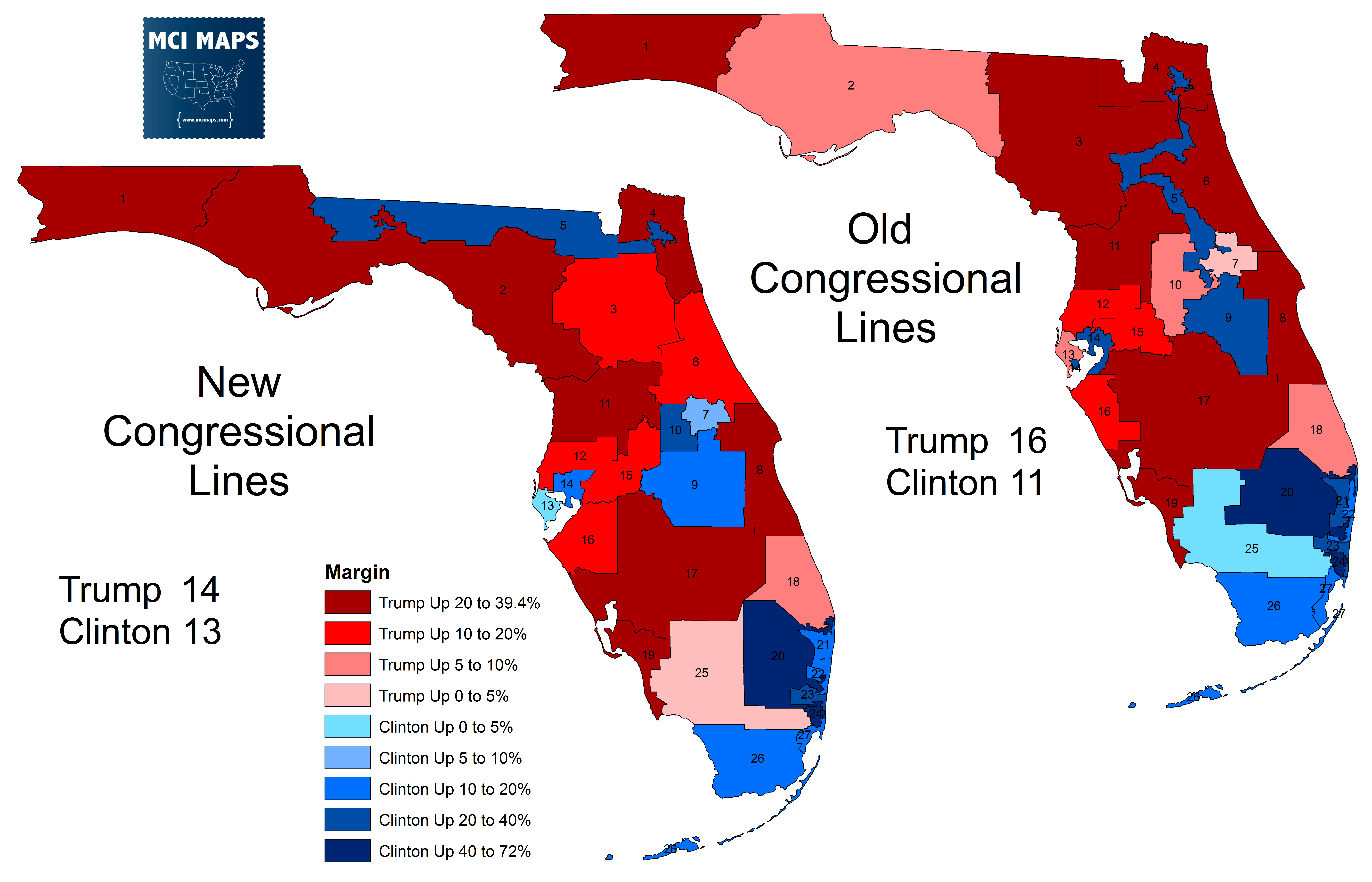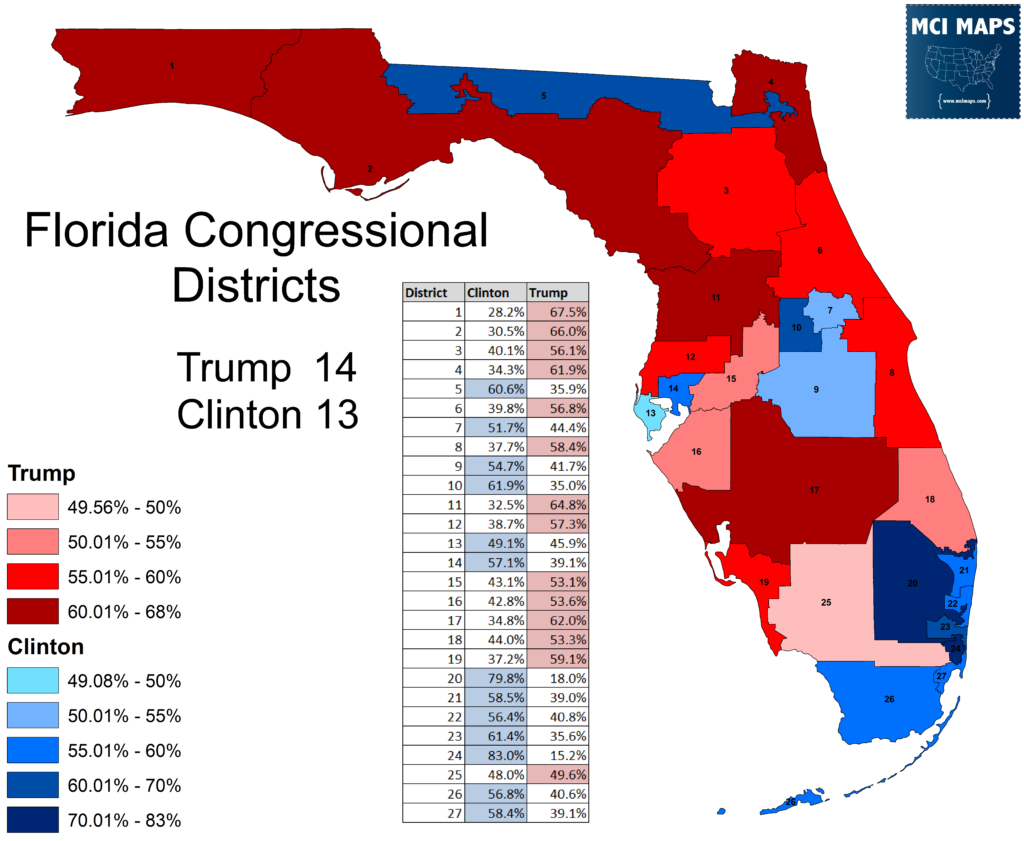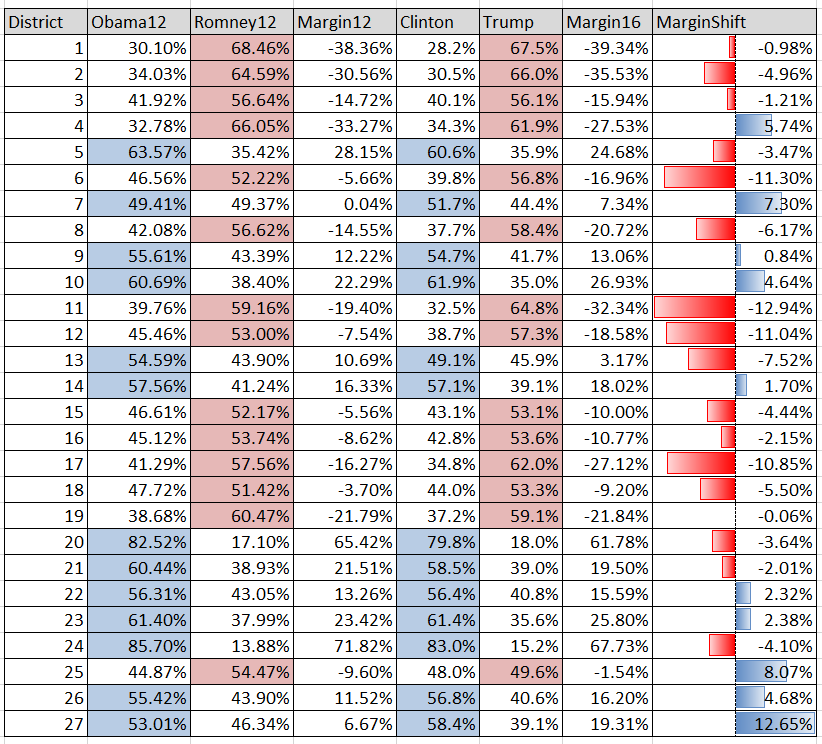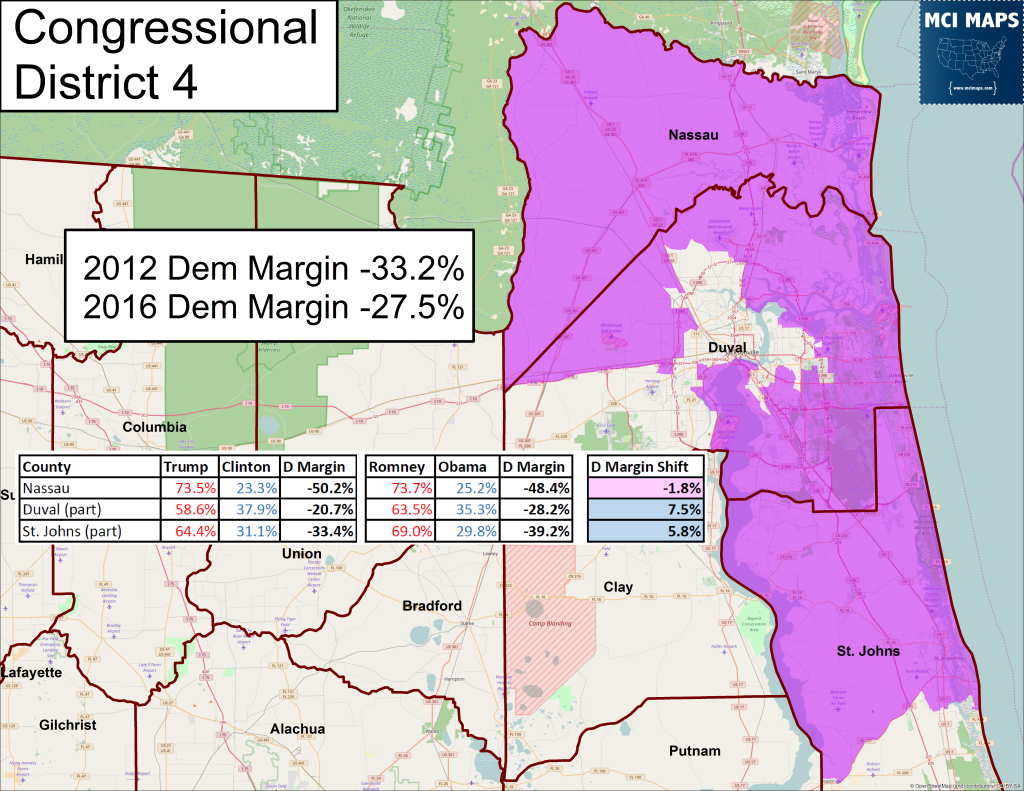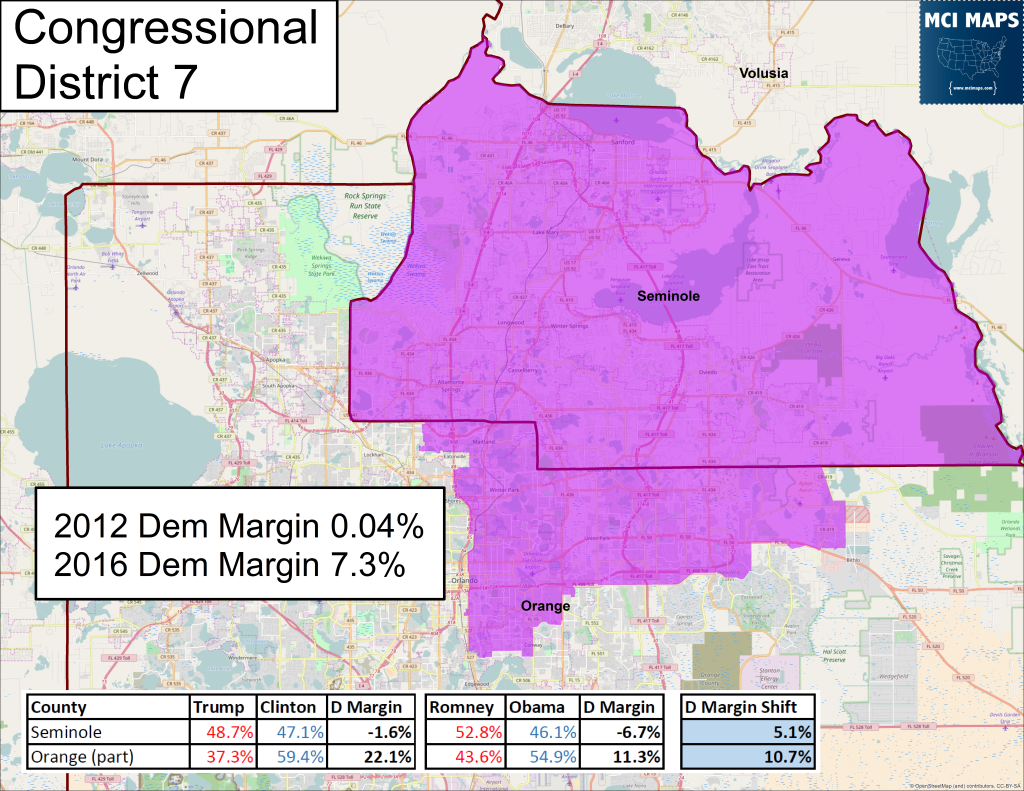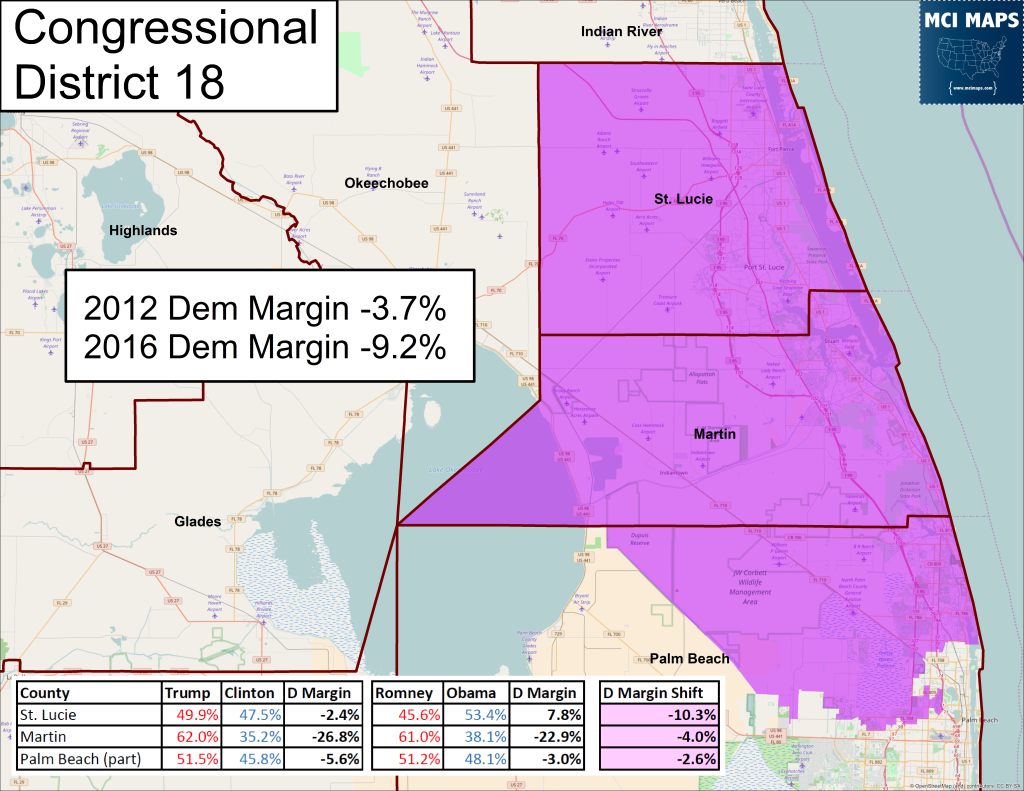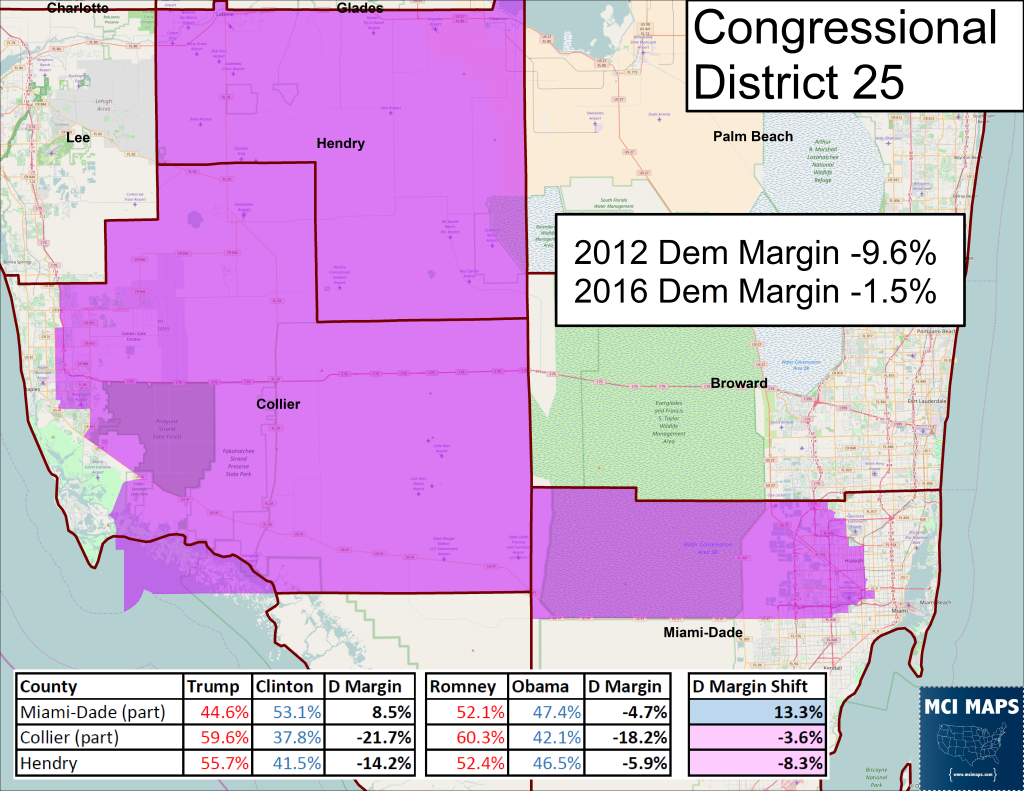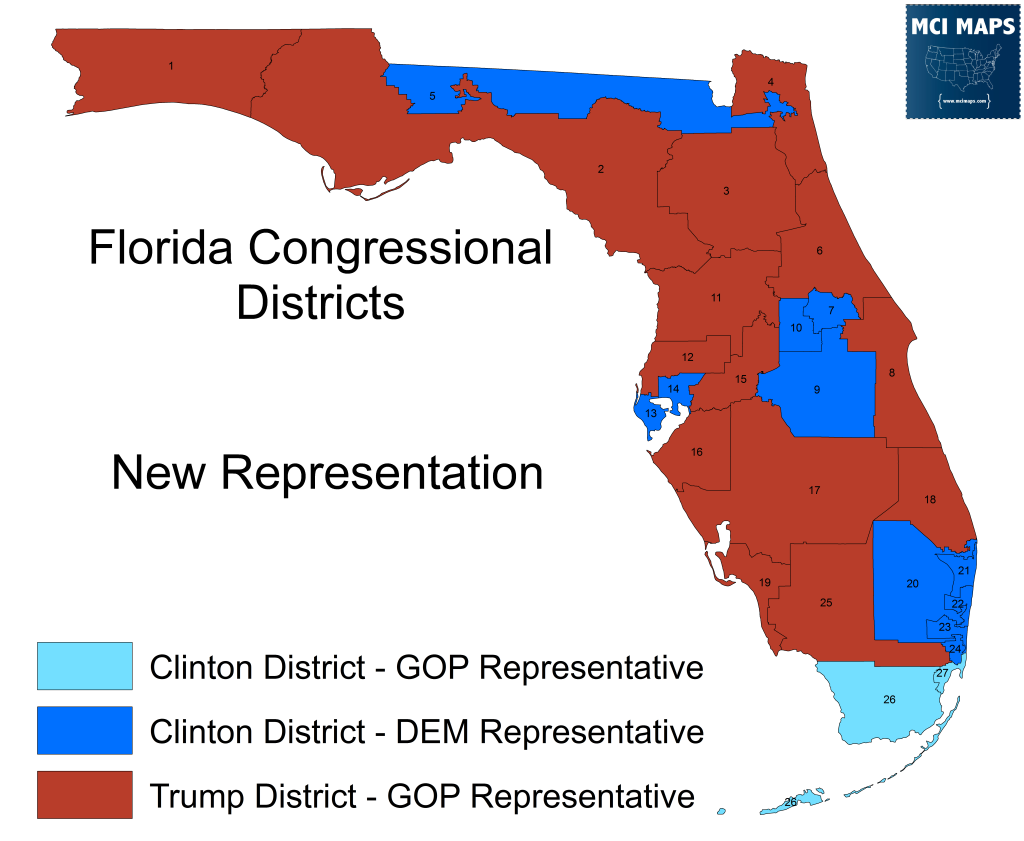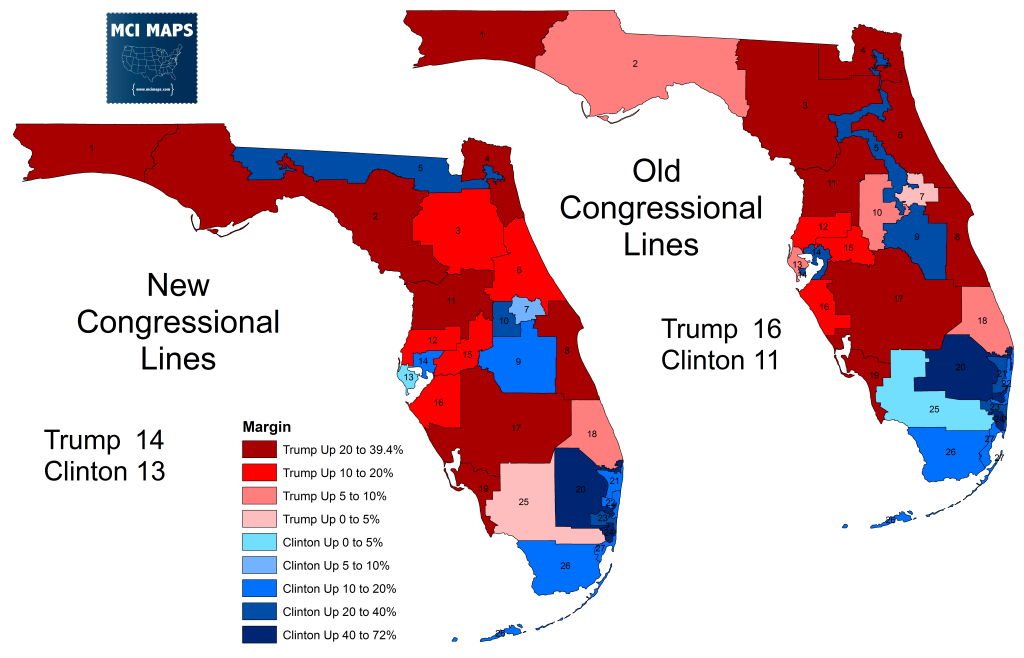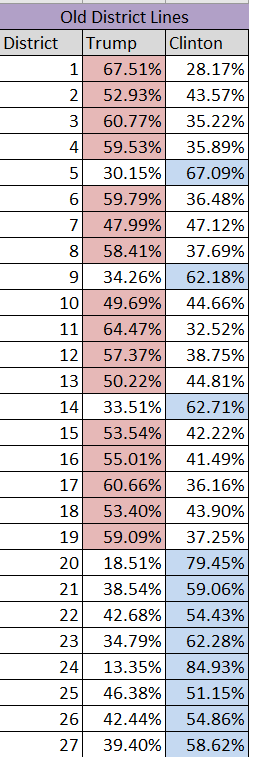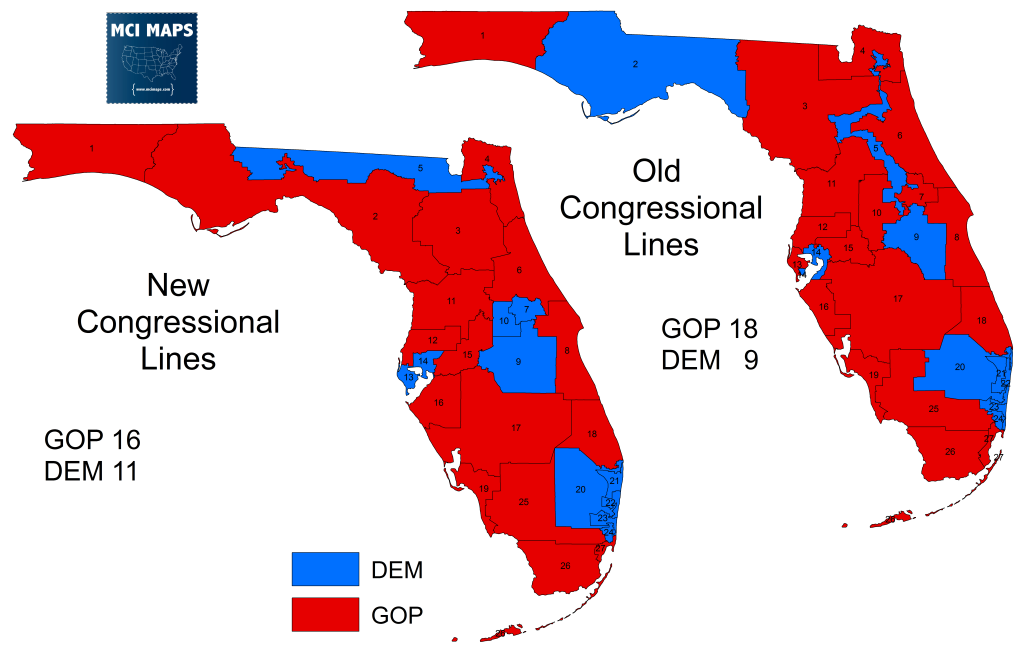In 2015, Florida was ordered to undergo a round of mid-decade redistricting after the Florida Supreme Court found the 2012 Congressional Plan passed by the GOP-controlled Florida legislature to be unconstitutional. When the legislature failed to agree on a map, a judge selected a plan drawn by the coalition plaintiffs – who had originally filed suit over the map. This year was the first time an election was held under this new map.
With the results in for Florida, and Donald Trump securing the state by a 1.2% margin, we can now look at how the congressional map held up.
The results by congressional district can be seen below. Donald Trump won 14 districts to Clinton’s 13.
Clinton won the Southeast Florida districts and secured the two Democrat-favored Tampa Bay seats. The new 5th district, the subject of much debate, went solidly for Clinton and sent Al Lawson, an African-American Democrat, to congress. This proved the old 5th, which went to Orlando, was indeed not needed to ensure minority representation.
Some notable results stand out. Trump drastically under-performed in the Hispanic-majority 25th, nearly losing it despite the seat going for Romney by 9% in 2012. Trump also lost the suburban 7th by 7% despite Romney and Obama virtually tying it in four years earlier. Clinton, meanwhile, only held on to the 13th by 3% despite Obama winning it by 10 points. In addition, the 18th, which went for Obama in 2008 and for Romney by 4% in 2012, went for Trump by 9%. These results correspond with the statewide trend seen in Florida. Clinton did worse with white working class regions while Trump did worse with Hispanic and suburban communities.
The shift in margins from 2012 to 2016 can be seen on the map and table below.
For Democrats, the biggest shift in their favor was the 27th, which went to Clinton by almost 20 points. Meanwhile, the biggest shift to the GOP was the 11th, though several others were right behind it.
Notable District Trends
Several districts saw major trends in both directions. However, there are a few districts in particular I would like to mention due to the nature and reasoning for their shifts.
The first district I want to mention is the 4th district. This seat is overwhelmingly GOP and will not become a democratic target anytime before the next ice age. However, it did see a solid 5 point shift in the Democratic party’s favor. The shift corresponds with the overall trends seen in Florida that night. First, rural Nassau county actually had an increase in the GOP margin, reflecting Trumps strength with that voting block. However, Duval and St Johns, made up heavily of white suburbanites, saw the margin become less GOP friendly. Trump’s well-documented problems with affluent and suburban voters fueled the shift in the 4th district.
The next district I wanted to mention was the 6th district.
The 6th is at the epicenter of Hillary Clinton’s problems with working class whites. Volusia and Flagler make up the heart of the district, and both went to Obama in 2008. Flagler slipped away from Obama in 2012, but he only narrowly lost Volusia. However, both counties went heavily against Clinton. The district had voted against Obama by 5 points and was seen as potential pickup for dems with the right candidate and environment. However, going against Clinton by 17 points will cause it to tumble down the DCCC watch list until the party’s fortunes improve in the region.
One other note. The southern portion of St Johns became more GOP despite the northern portion that lies in the 4th become less GOP. This is because the northern portion of the county is wealthier and fits in with many examples nation-wide Donald Trump under-performing in affluent communities.
The next district I am looking at is District 7.
The 7th district was a near tie between Obama and Romney in 2012. However, the district became much more Democratic thanks to suburban and Hispanic voters. The Seminole and North Orange portions of the district are made up heavily of white suburbs, while the southern portion of the district has a large Hispanic population. The shift towards Clinton in reliable-GOP Seminole County was especially notable on election night. However, the shift in Orange was even greater. This shift was too much for GOP Congressman John Mica, who lost by 3 points in his re-election bid.
My next district is the 18th
The 18th district represents another example of working-class white troubles for Democrats. The district leaned GOP, but had a Democratic anchor in the form of St Lucie County. However, St Lucie, which was a reliable blue county for Democratic Presidential candidates, went for Donald Trump, representing a 10 point swing toward the GOP. The shift in solid-GOP Martin County and the Republican northern suburbs of Palm Beach were modest. It was St Lucie that fueled the shift away from Democrats.
The final district I wanted to look at was the 25th
The 25th district was solid for Mitt Romney in 2012 but almost went for Clinton this year. This is entirely fueled by Trump’s problems in Miami-Dade county. Trump did better in Hendry and Collier, but Dade, which made up a large share of the vote, gave Trump the weakest share for a GOP candidate in a long time. The district goes into Hialeah, a former Cuban-GOP stronghold that Trump managed to win by only 100 or so votes. Trump’s weakness in Dade pushed the district towards the Democrats at a rapid pace.
–
New Representation
After all the ballots have been counted, Democrats will hold 11 districts to the GOP’s 16. Democrats lost the 2nd, which became too Republican for any Democratic to hold, and the 18th, which Murphy left to run for the Senate. Democrats, meanwhile, picked up the 10th, a new safe-Dem seat, the 13th, with Charlie Crist’s political comeback, and the 7th, with Mica falling to Stephanie Murphy. The Democrats control all but two of the districts Clinton won, the 26th and 27th.
Hispanic Republicans Carlos Curbelo and Ileana Ros-Lehtinen held on despite Trump getting decimated in both districts. In the case of the 26th, Democrat Joe Garcia was a damaged candidate, while in the 27th Ros-Lehtinen has proven tremendously popular.
The Effects of Redistricting
Since redistricting is still fresh in our minds, the question is, what if the old map stayed in place? Well, under the old lines, Trump would have won 16 districts to Clinton’s 11.
Clinton wins the 25th under the old map, but loses the 10th, 7th, and 13th.
If there is ever an argument that the old map wasn’t a GOP gerrymander, I point to these results as proof. Not only did the old map produce a split that would have been more worthy of Trump comfortably winning the state, but visually it looks a gerrymander, with the 5th, 10th, and 14th really standing out.
The difference in the maps would have also had an effect on the congressional delegation for the state. Under the new map, Democrats went from 10 to 11 congresspeople. However, had the old map remained in place, they likely would have fallen to 9.
Lets play this out a bit. If the old map had been used, the following events likely would have take place.
- Democrats lose the 18th due to Murphy running for the Senate (that district barely changed in redistricting)
- Gwen Graham wins re-election narrowly in the 2nd. While Trump’s 9 point win is solid, Graham proved to be a strong fundraiser, good congressperson with strong constituent outreach, and the GOP was finding trouble recruiting candidates before redistricting struck. The Trump margin would have kept it close, but I could easily see Graham pull off re-election.
- Charlie Crist doesn’t run in the 13th, as he only expressed interest once his house wound up in the district with redistricting. Had he or another Dem run, they would have likely fallen to moderate-congressman David Jolly in a district that voted for Trump by 5
- Stephanie Murphy either doesn’t run or loses in a district that narrowly backs Trump.
So under this scenario, Democrats get 9 seats. Even worse, they have to fight for those 9, as Gwen Graham’s re-election would be a tremendous battle due to the margin in the district.
Conclusions
The old map limited the ability of Democrats win win races despite the state routinely voting for statewide candidates by narrow margins. Under the new map, Democrats sit at 11 seats with room to grow. For the blue team, they will need to find candidates who can compete better in the Dade Hispanic community, which grows more blue for the Presidential race but still loves to ticket split down-ballot. Democrats would also be wise to keep an eye on the 25th district. Republicans may make plays to reclaim the 7th or 13th districts. Which districts get the attention in 2018 will depend on recruitment and how Trump looks in two years. Regardless, its safe to argue the new congressional map has produced a result much more in line with the statewide trends of Florida. A stark improvement over the old gerrymander.

